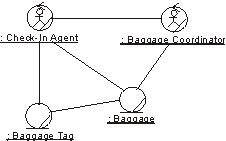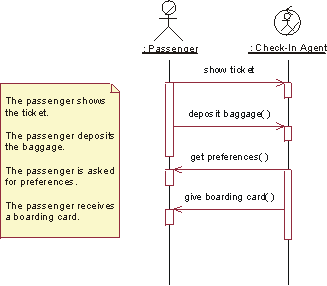Work Guidelines: Business Object Modeling Workshop
A productive way of finding business workers and business entities is to work in a group, using a whiteboard, easel, and Post-it® Notes.
Study the workflow of a business use-case. Mark each section to show responsibilities that would fit on one business worker or business entity. Use two colors of Post-it® Notes: one for business workers, and one for entities.
Now add all the relationships between business workers and business entities that are necessary to perform the workflow of the business use-case realization:
- Start with links to show how workers dynamically interact and handle business entities to perform the workflow of the business use-case realization. This will be the basis for you collaboration- and sequence-diagrams for the business use-case realization.
- Go on with static relationships to show the business workers’ and business entities’ long-lived relations required to perform the use case. This can be drawn on a separate chart, to avoid clutter.
If the number of business workers and business entities is large, you may need several diagrams. The following is recommended:
- One diagram that shows how the business workers interact (without showing any business entities).
- A diagram for each subflow of the business use-case realization. Each of these diagrams should contain just the business workers and business entities involved in the subflow. You could even limit the diagram by showing only the most interesting business entities.

A collaboration diagram documents how business workers and business entities are connected to perform a business use-case realization workflow.
Sequence diagrams, which are often more descriptive than collaboration diagrams, are good for describing the workflow in the following situations:
- When parts of the business use-case realization are complex or unclear.
- When there are few business workers and business entities involved, but many operations to perform.
- When it is important to show the exact sequence in a workflow, that is, of messages for operations by business workers and messages to operations of business entities.
If the number of business workers and business entities is too large, you may need several sequence diagrams. Our recommendations for collaboration diagrams are also valid for sequence diagrams. Start with the use-case realization’s normal workflow, following its structure. Continue with alternative subflows.
To draw a sequence diagram of a business use-case realization, do the following:
- Put all business workers and business entities that participate in the workflow into a sequence diagram.
- Describe how the business workers interact via messages. For each message, specify the operation it concerns. If a business worker handles a business entity, specify the operation it concerns.
- In the text margin, describe each activation (message requesting an operation).

A sequence diagram documents how business workers interact and handle business entities to perform the workflow of a business use-case realization.
When you are ready, save the information about each business worker and business entity (which activities it is supposed to perform). You will describe them later. Also save the information about the business use case and its realization, by copying the contents of the whiteboard (or take a picture of the whiteboard with a Polaroid™).
![]()